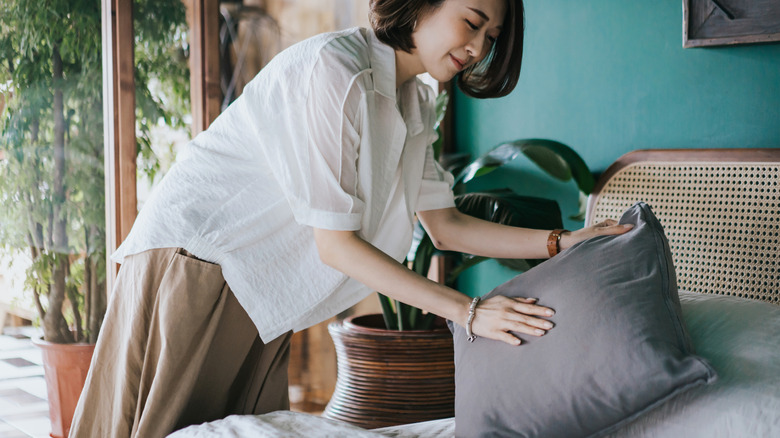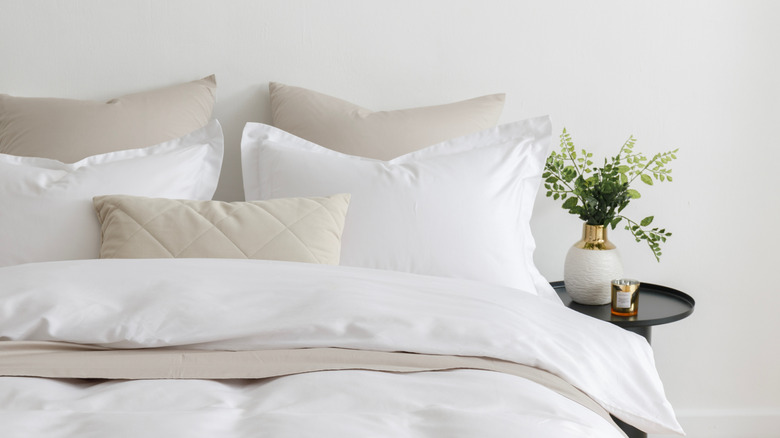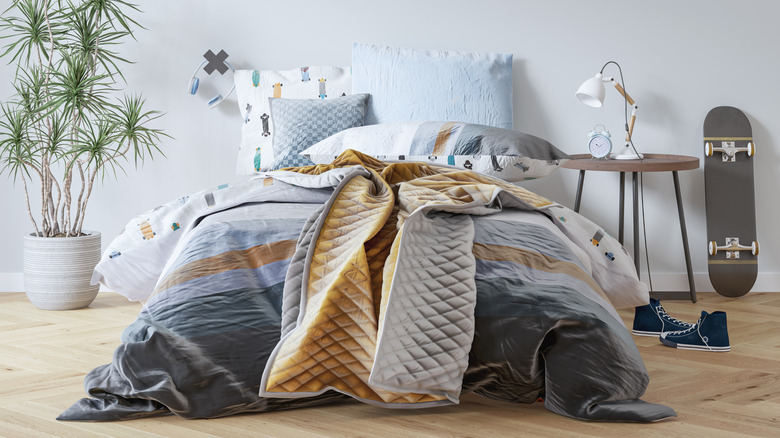The Once-Timeless Bedding Staple That's Starting To Feel Cold And Dated
What is more exciting or satisfying than a bedding overhaul? While it may not be a regular occurrence because you should be replacing your bedding only every few years (minus pillow cases), it still gives your rooms a whole new aesthetic when you do upgrade or swap out old duvets and sheets. When it comes to the latter, picking a color may be as simple as going with the traditional white sheets; however, these could be dating your space. While white has been a popular choice for years because of how easy it is to match, it could be creating a sterile and almost cold ambience, which other softer or warmer hues could avoid.
You don't have to completely ditch white within your bedroom, but as an anchor or base to your bedding, it's definitely worth considering a more inviting shade that balances your duvet and other elements. Rather than just opting for stark white, consider delving into the plethora of neutral off-whites, beige, creams, or why not use your sheet as a place to introduce patterns or bolder colors? It's true that white really does give you a lot to work with, which is why it has probably been such a big choice for the base of your bedding. However, with trends becoming more targeted towards inviting, cozy, and personalized spaces, the options to expand your color scheme within the bedroom have opened up exponentially. Just be mindful of mistakes you can make when layering your bedding.
White sheets can seem too cold or even dingy
Usually, white acts as a blank canvas to build your linens around. However, it can create a harsh and intense ambiance depending on what you pair it with, negating the cozy ambiance. Also, neon and pastel shades don't blend well with this neutral. White, while a neutral base color, is no longer dominating the interior design world and can actually create a flat or even cold and sterile vibe. While Nate Berkus swears by white for a fresh and clean space, keeping your bedding crisp can also be an exhausting task.
Not only do white sheets get yellow easily because of sweat and oils, making the color dull, but they can also get dirty from a number of other elements. Pet hair and dander, liquids, and just regular use will make white sheets dingy, which will also pull the overall bedding down. Rather than relying on such a sterile color, you can really create a cozy, intimate ambiance by swapping white for beige, cream, or even a taupe shade. This is if you prefer to stick with a color closer to white. However, what would really add dimension and even texture to your room is to pick sheets with prints or patterns on them and fold your duvet over to expose them when the bed is made. This allows you to really define your bedroom's aesthetic.
Mix and match patterns and colors
Mixing and matching patterns and prints through textiles is one of the easiest ways to bring multiple colors and patterns into your room. If your duvet has a pattern, consider using sheets with a solid color that matches one or more of its elements. This will create a fuller effect. However, if you have bedding that's simple or even plain, your sheets are the ideal place to introduce a print. This could be stripes, checkers, small decals, or something more bold, like florals. Because only a small amount of your sheets will peek out, especially if you fold over your duvet, this will avoid creating visual clutter within the room. However, it will still give you the opportunity to introduce a little bit more dimension and style.
Bedding plays by different rules than other textiles in your home. Try using florals for the base sheets, then adding another layer of stripes for a combination to create interest without overdoing it. Or use a bold stripe for your sheets, then pair it with a matching solid on the duvet. Lastly, using all solids but layering different colors creates a fuller effect, too. Pick bold shades like blue, red, green, and even mustard to layer together, or use a monochromatic palette that has various shades of the same hue.


